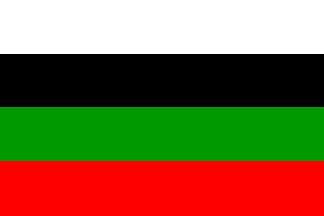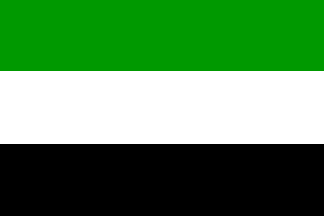![[Arab Revolt Flag]](../images/x/xo-arabc.gif) image by Filip Van Laenen, 3 November 1996
image by Filip Van Laenen, 3 November 1996Arab Revolt Flag

Last modified: 2020-08-02 by ian macdonald
Keywords: pan-arab colours | arab revolt | hejaz | triangle: hoist (red) | arab liberation flag | arab nationalism | egypt | iraq | jordan | kuwait | palestine | sudan | syria | transjordan | united arab emirates | western sahara | yemen |
Links: FOTW homepage |
search |
disclaimer and copyright |
write us |
mirrors
![[Arab Revolt Flag]](../images/x/xo-arabc.gif) image by Filip Van Laenen, 3 November 1996
image by Filip Van Laenen, 3 November 1996
Arab Revolt Flag
See also:
Other sites:
From the PASSIA home page:
Quoted source: Abdul Hadi 1986 [hdi86].
 image by Ivan Sache, 21 June 2003
image by Ivan Sache, 21 June 2003
According to P. Lux-Wurm, Les drapeaux de l'Islam ([lux01]), the use of
these colours by Arab liberation movements can be traced back to the beginning of the 20th century.
The Arab Literature Club was founded in Istanbul (Turkey) in 1909. Its
flag was horizontally divided white-black-green-red. The four colours of
the flag refered to a poem by Safi al-Din-al-Hili (1278-1349): "White are our acts, black our battles,
green our fields, And red our swords." The flag of the Arab Literature club vanished in 1911, when new
movements took the leadership of pan-Arabism.
Ivan Sache, 21 June 2003
 image by Ivan Sache, 21 June 2003
image by Ivan Sache, 21 June 2003
In March 1914, the Society of Young Arabs was founded in Beirut
(Lebanon). Its agenda was to fight against the Ottoman Empire until the
independence of the Arab countries. In August 1914, when the first World
War broke out, the movement spread to other Moslim countries. The Party
for Ottoman Decentralization (Hizb al-lamrkaziya al-idariya al-uthmani)
was founded in Cairo (Egypt) by Syrians. Its agenda was the fight for
decentralization and autonomy of the provinces within the Ottoman
Empire. Both organizations used the same flag, horizontally divided
green-white-black. The symbolism of the colours was described by the
Party for Ottoman Decentralization in an official statement as follows:
"Praise be to our nation covered by the night (black), by our consciousness (white) and by hope (green)."
There was no explicit religious reference, most probably because the Party called for struggle between
Muslim countries.
Ivan Sache, 12 June 2003
![[Arab Revolt Flag]](../images/x/xo-arabc.gif) image by Filip Van Laenen, 3 November 1996
image by Filip Van Laenen, 3 November 1996
From the PASSIA home page:
"Sharif Hussein designed the flag of the Arab Revolt on June 1916. The Palestinian people raised it as the flag of the Arab National
movement in 1917. In 1947, the Arab Ba'ath Party interpreted the flag as a symbol of the liberation and unity of the Arab nation. The
Palestinian people readopted the flag at the Palestinian conference in Gaza in 1948. The flag was recognized by the Arab League as the
flag of the Palestinian people. It was further endorsed by the PLO, the representative of the Palestinians, at the Palestinian conference
in Jerusalem in 1964."
Quoted source: Abdul Hadi 1986 [hdi86].
After the fall of Hejaz the colors were used by Husain's sons 'Abdulla (emir of the Transjordan) and Faisal (king of Iraq). Later on
they became known as the Pan-Arab colors.
Harald Müller, 13 March 1996
The flag of Sharif Hussein of Hejaz, was a conscious union of the old Islamic dynasties, plus the red of Sharifian clan. The red also
came to symbolise revolt against the Turks. Husain's 3 sons became kings of Jordan, Syria, and Iraq, hence the minor differentiations in the Sharifian flag. Hussein's original
intent was for his flag to be identical in those 3 countries with the addition of one star for Jordan-Palestine, two stars for Iraq, and
three stars for Syria. The Jordanian one is the only that has survived, and the Palestinians use the same flag
without the star as a tie to their original territorial integrity. (Palestine and Transjordan were split in
1923 to clarify that a Jewish homeland did not apply to the latter.) In 1961 Kuwait switched from its red Gulf flag
to a Sharifian variant.
T. F. Mills, April 1998
During World War I, Arabs in the Hejaz (the Red Sea coast of the Arabian peninsula) rose up against the Ottoman Sultan, with the help of the British, who were fighting the Ottomans at the time. The revolt was headed
by the Hashemite dynasty of Mecca, and their banner was red, white, green, and red. Jordan is the last state left
with a Hashemite ruling king, and thus its flag is closest to the original model. The colours are intended to correspond to the early
Islamic dynasties of the first half of the middle ages; this is probably an "invented tradition," as the use of flags by such dynasties
is anachronistic.
The Hashemite revolt was the Arab world's first embrace of European-style nationalism, but it was largely unsuccessful, mostly due to
lack of Western support. The Arab-speaking areas of the old Ottoman empire were mostly divided up between France and England, though the
British did install Hashemite princes as local rulers in the areas they controlled. Even in the Hejaz, the Hashemites were driven out by
the Wahabi Saudi dynasty, which, then as now, was less concerned with Arab nationalism than in its doctrine of
religious fundamentalism. Nevertheless the flag was remembered as associated with Arab nationalism, even if the
Hashemite dynasty was not.
Joshua Fruhlinger, 11 January 1999
There most probably were no specifications for the Arab Revolt flag other
than the colours (with no specific shades either) and the overall geometrical
design (three stripes and hoist triangle). There are some interesting data and a
reference to a photograph of an actual flag here.
Unlike the Jordanian flag, the original Arab Revolt flag appears to have been
shorter, possibly ca. 2:3.
Santiago Dotor, 31 December 2013
![[Arab Liberation Flag]](../images/x/xo-arablib.gif) image
by Santiago Dotor, 11 May 1999
image
by Santiago Dotor, 11 May 1999
The Egyptian revolution of 1953 gave birth to the "Arab Liberation Flag" wherein the pan-Arab red-white-black
tricolour took on new meaning. Black stands for the past history of foreign oppression, white stands for the bright future, and red
stands for the bloody sacrifice required to get from the black to the white. Radical states (e.g. Ba'athists) have adopted variants while
preserving the basic symbolism.
T. F. Mills, Aril 1998
When the next phase of Arab nationalism began, in the aftermath of WWII, it was dominated by pan-Arabist parties like the Ba'ath party
and military strongmen who set up republics. Although this wave of nationalism swept away the Hashemite king of Iraq, most of its leaders used a red-white-black banner derived from the original Arab revolt. Egypt adopted a red-white-black flag at this time, though not identical to the current model. The fact that this flag
adoption coincides with the adoptions of very similar flags by Syria, Iraq, Yemen and Libya (Qadaffi's all-green flag didn't come in till later) seems to prove false the
idea that said colors are inherently Egyptian. In fact, the Egyptian regime that made this flag choice is the same one that would later
participate in the short-lived experiment of the United Arab Republic, a brief union between Egypt and
Syria. This project shows aspirations beyond mere Egyptianism. Since this tide of Arab nationalism did not result in Arab unity, as the
failure of the UAR helped show, it is not surprising that the current Egyptian government ties the color scheme to purely Egyptian
ideologies. However, I think this helps demonstrate the dangers of taking "official" descriptions of flags at face value.
Joshua Fruhlinger, 11 January 1999
The stars that serve to differentiate most of these flags have practical meanings. The Sharifian flags [Jordan,
Iraq 1920-1924 and 1924-1958] have seven-pointed stars symbolising the seven
fundamental verses of the first Surah of the Qu'ran. The Arab Liberation flags have five-pointed stars: The
United Arab Republic flag of 1958 had two stars (in green to restore the missing pan-Arab colour) representing Egypt
and Syria. In 1962 the Yemen Arab Republic (North Yemen) adopted a one-star version (representing unity and
independence). In 1967 the People's Democratic Republic of South Yemen adopted a version with one red star on
a light blue triangle (the star being the National Liberation Front leading the blue people). United Yemen's flag
in 1990 is a plain tricolour with no stars. In 1963 Syria and Iraq switched to 3
stars to represent pan-Arab (Ba'athist) solidarity (and Iraq alone has that flag today). In 1972 Egypt, Syria and Libya formed the Federation of Arab Republics incorporating the hawk (not eagle) of the Quraish, which represents the tribe of
Muhammad, instead of stars. The Federation did not last long, and Syria in 1980 reverted back to the two-star UAR flag, and Libya in 1977 switched to a plain green flag (representing the "green revolution").
T. F. Mills, April 1998
![[Arab Revolt Emblem]](../images/x/xo-arab).gif) image located by Rob Raeside, 25 January 2016
image located by Rob Raeside, 25 January 2016
Kindly find the attached and the links for the Jordanian celebrations of
Great Arab Revolt which.
http://www.petra.gov.jo/Public_News/Nws_NewsDetails.aspx?lang=2&site_id=1&NewsID=234268&CatID=13
Arab Revolt Emblem:
http://www.jordantimes.com/news/local/emblem-marking-great-arab-revolt-centennial-unveiled
Mohammed Noghuy, 25 January 2016
Emblem carries the flags of the
Hashemite Kingdom,
Jordan and the Arab Revolt.
Rob Raeside, 25 January 2016
In 2016 the US Jordanian Embassy published the following (source)
- "The parade, which was the culmination of the Kingdom’s celebrations of the
Great Arab Revolt Centennial and the
Arab Awakening
anniversary..."
- "The parade coincides with the anniversary of the passing away of the Great
Arab Revolt leader, Sharif Hussein bin Ali, who fired its first shot on 10 June
1916."
Esteban Rivera, 06 January 2017
In other online articles (basically
here), they
mention that the original design was made by "British diplomat Sir Mark Sykes,
in an effort to create a feeling of "Arab-ness" in order to fuel the revolt.
Source: "William Easterly, The White Man's Burden, (2006) p. 295". And
here's also a list
of related flags.
Esteban Rivera, 14 January 2017